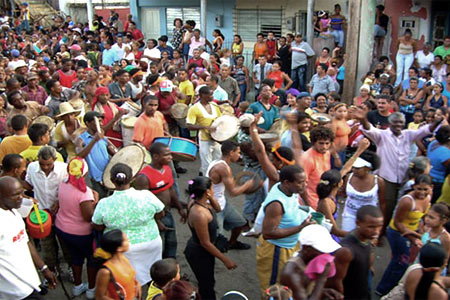5.5 Origins and present day of the Santiago de Cuba Carnival.

At the end of the 17th century in Cuba, the Santiago de Cuba Carnival was born with the religious procession in honor of the patron saint Santiago the Apostle, which on July 25th ran through the streets adjacent to the Cathedral of Santiago de Cuba (Heredia between San Félix and Santo Tomás, Santiago de Cuba). These processions later took place on the days of San Juan (June 24th), San Pedro (June 29th), Santa Cristina (July 24th) and Santa Ana (July 26th), based on African and Franco-Haitian elements in dance, music and costumes. This celebration was called the Fiesta de los Mamarrachos (Feast of the Mamarrachos), and town councils and parranda groups were incorporated, singing songs to liven up the festivities.
Congas and comparsas are currently present at the annual parranda; and the African-origin groups are the precursors to the comparsas that liven up the city of Santiago during these times. Mamarrachos and dolls representing characters from literature and children’s world parade, entertaining both adults and children.
The conga lines are a popular gathering among the people, who sing and dance to catchy improvised choruses through the streets of Santiago de Cuba to the rhythm of drums, Chinese horns, and other percussion instruments. The groups, made up of dozens of dancers in colorful costumes, perform choreographies related to Caribbean customs and the life of the people of Santiago de Cuba. Beautifully decorated floats with light effects, on which people also dance, parade. The parade passes through several areas of the city.
This Santiago de Cuba carnival is currently celebrated for seven days in the second half of July. Its origins are linked to the need to keep our traditions alive; the Santiago de Cuba carnival is considered one of the three most recognized popular festivals in the country. This type of celebration particularly emphasizes the African and Caribbean component, reflected in the music and dance that accompany the rejoicing in the streets.








